NRSG366 Semester 1 Case Study: Diabetic Patient Analysis
VerifiedAdded on 2023/01/19
|8
|2359
|68
Case Study
AI Summary
This case study focuses on a 52-year-old male patient with type 2 diabetes, obesity, hypertension, sleep apnea, and gastro-oesophageal reflux disorder. The assignment requires identifying and discussing two priorities of care: uncontrolled diabetes and social isolation. The student applies the clinical reasoning cycle, including assessing the patient's situation, collecting information, processing it, identifying problems, setting goals, taking action, evaluating results, and reflecting on the process. Nursing interventions include monitoring blood glucose levels, encouraging social activity, managing medications, addressing weight issues, and promoting healthy habits. The student reflects on the challenges of managing diabetes, the importance of patient education, and the need for comprehensive nursing interventions, including family involvement and addressing psychological factors. The case highlights the significance of clinical reasoning in prioritizing care and achieving positive patient outcomes, emphasizing the need for effective nursing interventions and a holistic approach to patient care.

Running Head: DIABETIC PATIENT
0
Diabetic Patient
Essay
student
4/14/2019
0
Diabetic Patient
Essay
student
4/14/2019
Paraphrase This Document
Need a fresh take? Get an instant paraphrase of this document with our AI Paraphraser
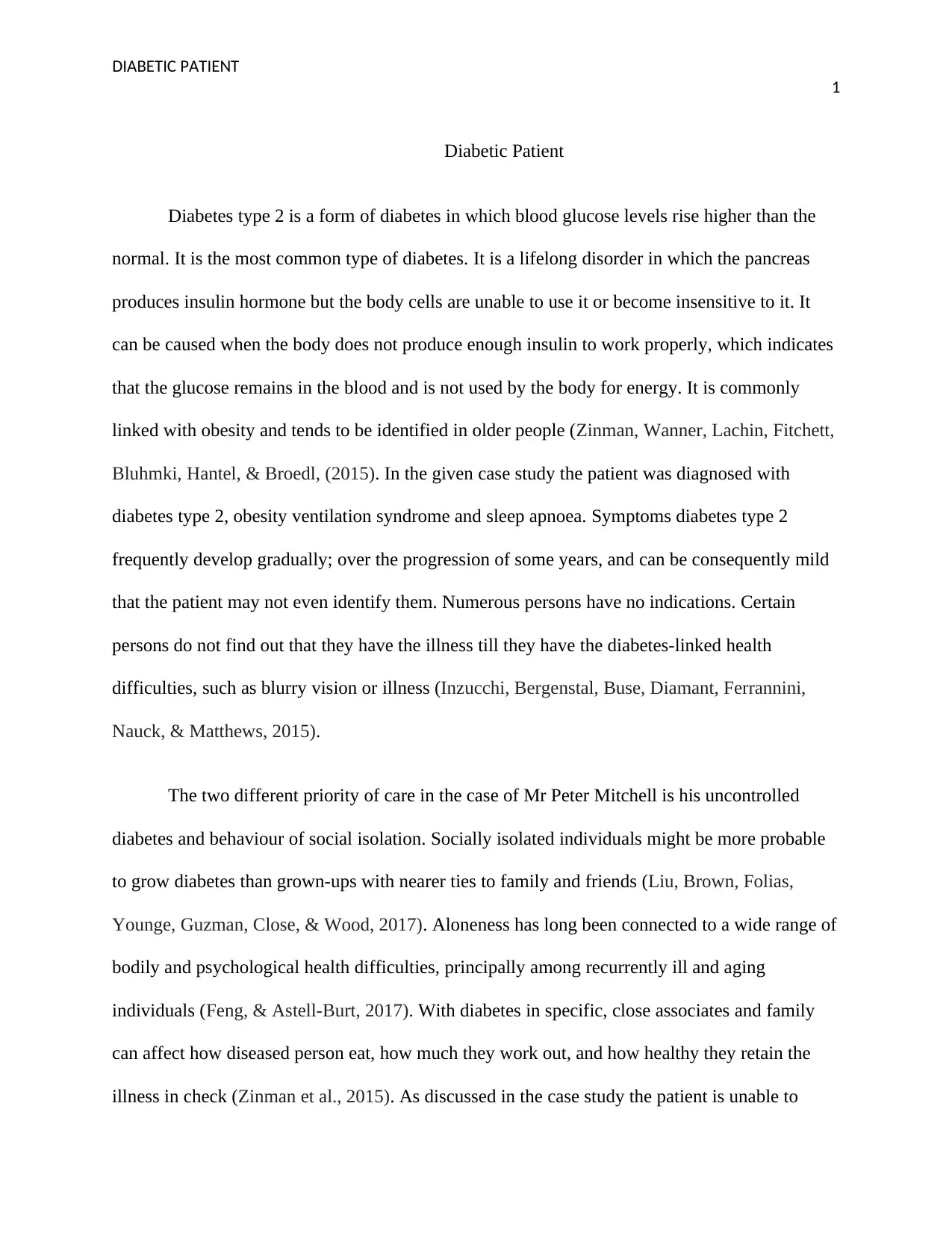
DIABETIC PATIENT
1
Diabetic Patient
Diabetes type 2 is a form of diabetes in which blood glucose levels rise higher than the
normal. It is the most common type of diabetes. It is a lifelong disorder in which the pancreas
produces insulin hormone but the body cells are unable to use it or become insensitive to it. It
can be caused when the body does not produce enough insulin to work properly, which indicates
that the glucose remains in the blood and is not used by the body for energy. It is commonly
linked with obesity and tends to be identified in older people (Zinman, Wanner, Lachin, Fitchett,
Bluhmki, Hantel, & Broedl, (2015). In the given case study the patient was diagnosed with
diabetes type 2, obesity ventilation syndrome and sleep apnoea. Symptoms diabetes type 2
frequently develop gradually; over the progression of some years, and can be consequently mild
that the patient may not even identify them. Numerous persons have no indications. Certain
persons do not find out that they have the illness till they have the diabetes-linked health
difficulties, such as blurry vision or illness (Inzucchi, Bergenstal, Buse, Diamant, Ferrannini,
Nauck, & Matthews, 2015).
The two different priority of care in the case of Mr Peter Mitchell is his uncontrolled
diabetes and behaviour of social isolation. Socially isolated individuals might be more probable
to grow diabetes than grown-ups with nearer ties to family and friends (Liu, Brown, Folias,
Younge, Guzman, Close, & Wood, 2017). Aloneness has long been connected to a wide range of
bodily and psychological health difficulties, principally among recurrently ill and aging
individuals (Feng, & Astell-Burt, 2017). With diabetes in specific, close associates and family
can affect how diseased person eat, how much they work out, and how healthy they retain the
illness in check (Zinman et al., 2015). As discussed in the case study the patient is unable to
1
Diabetic Patient
Diabetes type 2 is a form of diabetes in which blood glucose levels rise higher than the
normal. It is the most common type of diabetes. It is a lifelong disorder in which the pancreas
produces insulin hormone but the body cells are unable to use it or become insensitive to it. It
can be caused when the body does not produce enough insulin to work properly, which indicates
that the glucose remains in the blood and is not used by the body for energy. It is commonly
linked with obesity and tends to be identified in older people (Zinman, Wanner, Lachin, Fitchett,
Bluhmki, Hantel, & Broedl, (2015). In the given case study the patient was diagnosed with
diabetes type 2, obesity ventilation syndrome and sleep apnoea. Symptoms diabetes type 2
frequently develop gradually; over the progression of some years, and can be consequently mild
that the patient may not even identify them. Numerous persons have no indications. Certain
persons do not find out that they have the illness till they have the diabetes-linked health
difficulties, such as blurry vision or illness (Inzucchi, Bergenstal, Buse, Diamant, Ferrannini,
Nauck, & Matthews, 2015).
The two different priority of care in the case of Mr Peter Mitchell is his uncontrolled
diabetes and behaviour of social isolation. Socially isolated individuals might be more probable
to grow diabetes than grown-ups with nearer ties to family and friends (Liu, Brown, Folias,
Younge, Guzman, Close, & Wood, 2017). Aloneness has long been connected to a wide range of
bodily and psychological health difficulties, principally among recurrently ill and aging
individuals (Feng, & Astell-Burt, 2017). With diabetes in specific, close associates and family
can affect how diseased person eat, how much they work out, and how healthy they retain the
illness in check (Zinman et al., 2015). As discussed in the case study the patient is unable to
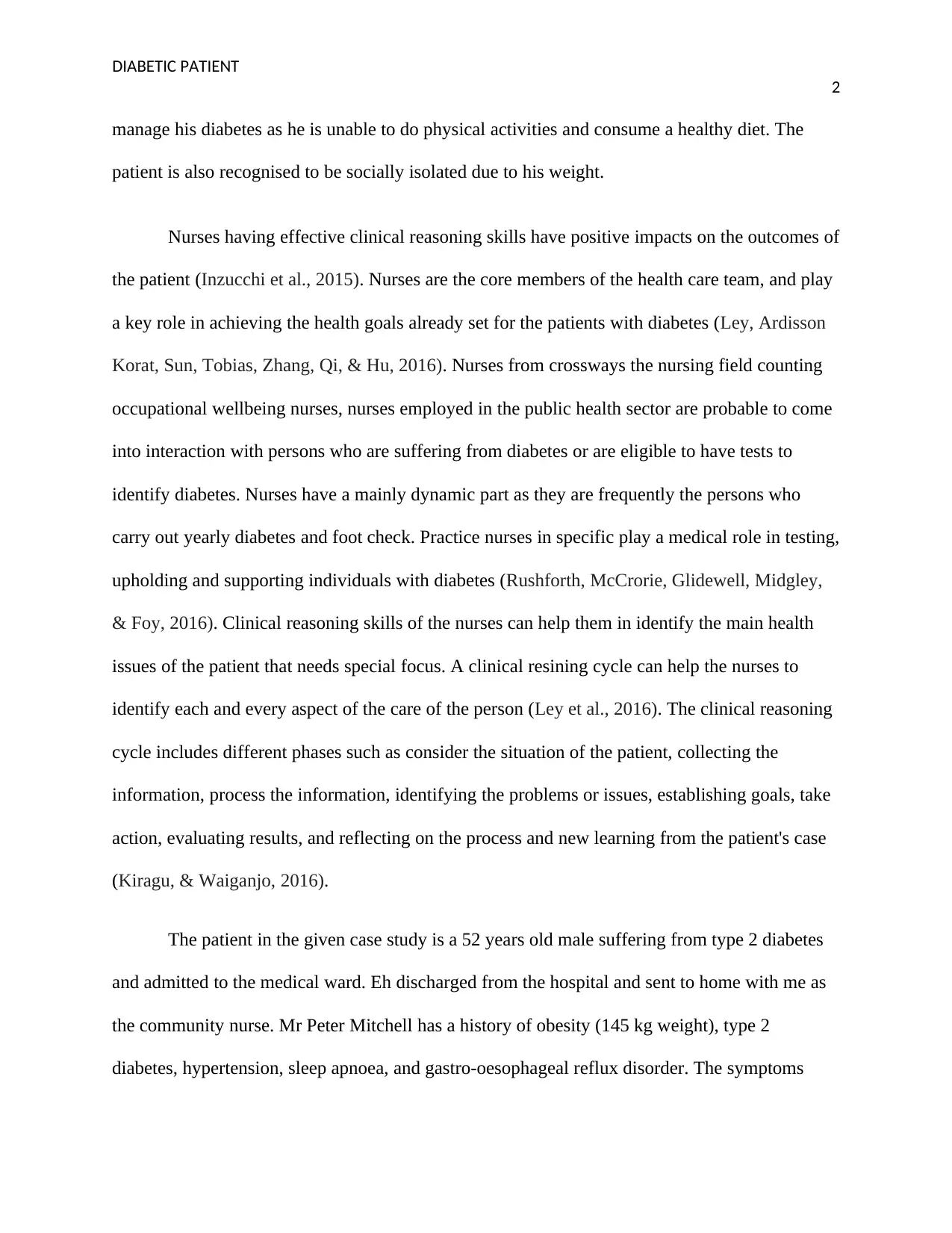
DIABETIC PATIENT
2
manage his diabetes as he is unable to do physical activities and consume a healthy diet. The
patient is also recognised to be socially isolated due to his weight.
Nurses having effective clinical reasoning skills have positive impacts on the outcomes of
the patient (Inzucchi et al., 2015). Nurses are the core members of the health care team, and play
a key role in achieving the health goals already set for the patients with diabetes (Ley, Ardisson
Korat, Sun, Tobias, Zhang, Qi, & Hu, 2016). Nurses from crossways the nursing field counting
occupational wellbeing nurses, nurses employed in the public health sector are probable to come
into interaction with persons who are suffering from diabetes or are eligible to have tests to
identify diabetes. Nurses have a mainly dynamic part as they are frequently the persons who
carry out yearly diabetes and foot check. Practice nurses in specific play a medical role in testing,
upholding and supporting individuals with diabetes (Rushforth, McCrorie, Glidewell, Midgley,
& Foy, 2016). Clinical reasoning skills of the nurses can help them in identify the main health
issues of the patient that needs special focus. A clinical resining cycle can help the nurses to
identify each and every aspect of the care of the person (Ley et al., 2016). The clinical reasoning
cycle includes different phases such as consider the situation of the patient, collecting the
information, process the information, identifying the problems or issues, establishing goals, take
action, evaluating results, and reflecting on the process and new learning from the patient's case
(Kiragu, & Waiganjo, 2016).
The patient in the given case study is a 52 years old male suffering from type 2 diabetes
and admitted to the medical ward. Eh discharged from the hospital and sent to home with me as
the community nurse. Mr Peter Mitchell has a history of obesity (145 kg weight), type 2
diabetes, hypertension, sleep apnoea, and gastro-oesophageal reflux disorder. The symptoms
2
manage his diabetes as he is unable to do physical activities and consume a healthy diet. The
patient is also recognised to be socially isolated due to his weight.
Nurses having effective clinical reasoning skills have positive impacts on the outcomes of
the patient (Inzucchi et al., 2015). Nurses are the core members of the health care team, and play
a key role in achieving the health goals already set for the patients with diabetes (Ley, Ardisson
Korat, Sun, Tobias, Zhang, Qi, & Hu, 2016). Nurses from crossways the nursing field counting
occupational wellbeing nurses, nurses employed in the public health sector are probable to come
into interaction with persons who are suffering from diabetes or are eligible to have tests to
identify diabetes. Nurses have a mainly dynamic part as they are frequently the persons who
carry out yearly diabetes and foot check. Practice nurses in specific play a medical role in testing,
upholding and supporting individuals with diabetes (Rushforth, McCrorie, Glidewell, Midgley,
& Foy, 2016). Clinical reasoning skills of the nurses can help them in identify the main health
issues of the patient that needs special focus. A clinical resining cycle can help the nurses to
identify each and every aspect of the care of the person (Ley et al., 2016). The clinical reasoning
cycle includes different phases such as consider the situation of the patient, collecting the
information, process the information, identifying the problems or issues, establishing goals, take
action, evaluating results, and reflecting on the process and new learning from the patient's case
(Kiragu, & Waiganjo, 2016).
The patient in the given case study is a 52 years old male suffering from type 2 diabetes
and admitted to the medical ward. Eh discharged from the hospital and sent to home with me as
the community nurse. Mr Peter Mitchell has a history of obesity (145 kg weight), type 2
diabetes, hypertension, sleep apnoea, and gastro-oesophageal reflux disorder. The symptoms
⊘ This is a preview!⊘
Do you want full access?
Subscribe today to unlock all pages.

Trusted by 1+ million students worldwide
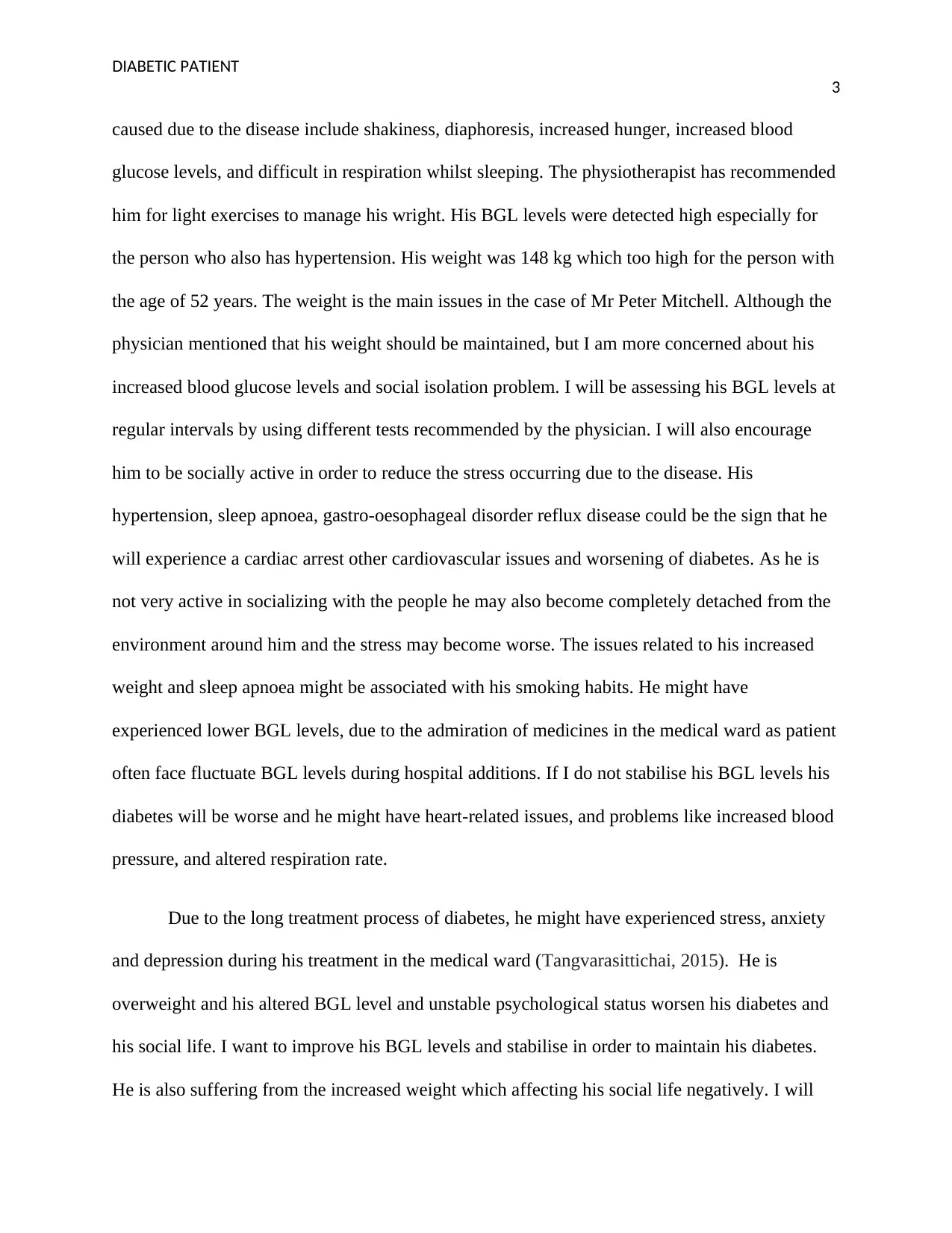
DIABETIC PATIENT
3
caused due to the disease include shakiness, diaphoresis, increased hunger, increased blood
glucose levels, and difficult in respiration whilst sleeping. The physiotherapist has recommended
him for light exercises to manage his wright. His BGL levels were detected high especially for
the person who also has hypertension. His weight was 148 kg which too high for the person with
the age of 52 years. The weight is the main issues in the case of Mr Peter Mitchell. Although the
physician mentioned that his weight should be maintained, but I am more concerned about his
increased blood glucose levels and social isolation problem. I will be assessing his BGL levels at
regular intervals by using different tests recommended by the physician. I will also encourage
him to be socially active in order to reduce the stress occurring due to the disease. His
hypertension, sleep apnoea, gastro-oesophageal disorder reflux disease could be the sign that he
will experience a cardiac arrest other cardiovascular issues and worsening of diabetes. As he is
not very active in socializing with the people he may also become completely detached from the
environment around him and the stress may become worse. The issues related to his increased
weight and sleep apnoea might be associated with his smoking habits. He might have
experienced lower BGL levels, due to the admiration of medicines in the medical ward as patient
often face fluctuate BGL levels during hospital additions. If I do not stabilise his BGL levels his
diabetes will be worse and he might have heart-related issues, and problems like increased blood
pressure, and altered respiration rate.
Due to the long treatment process of diabetes, he might have experienced stress, anxiety
and depression during his treatment in the medical ward (Tangvarasittichai, 2015). He is
overweight and his altered BGL level and unstable psychological status worsen his diabetes and
his social life. I want to improve his BGL levels and stabilise in order to maintain his diabetes.
He is also suffering from the increased weight which affecting his social life negatively. I will
3
caused due to the disease include shakiness, diaphoresis, increased hunger, increased blood
glucose levels, and difficult in respiration whilst sleeping. The physiotherapist has recommended
him for light exercises to manage his wright. His BGL levels were detected high especially for
the person who also has hypertension. His weight was 148 kg which too high for the person with
the age of 52 years. The weight is the main issues in the case of Mr Peter Mitchell. Although the
physician mentioned that his weight should be maintained, but I am more concerned about his
increased blood glucose levels and social isolation problem. I will be assessing his BGL levels at
regular intervals by using different tests recommended by the physician. I will also encourage
him to be socially active in order to reduce the stress occurring due to the disease. His
hypertension, sleep apnoea, gastro-oesophageal disorder reflux disease could be the sign that he
will experience a cardiac arrest other cardiovascular issues and worsening of diabetes. As he is
not very active in socializing with the people he may also become completely detached from the
environment around him and the stress may become worse. The issues related to his increased
weight and sleep apnoea might be associated with his smoking habits. He might have
experienced lower BGL levels, due to the admiration of medicines in the medical ward as patient
often face fluctuate BGL levels during hospital additions. If I do not stabilise his BGL levels his
diabetes will be worse and he might have heart-related issues, and problems like increased blood
pressure, and altered respiration rate.
Due to the long treatment process of diabetes, he might have experienced stress, anxiety
and depression during his treatment in the medical ward (Tangvarasittichai, 2015). He is
overweight and his altered BGL level and unstable psychological status worsen his diabetes and
his social life. I want to improve his BGL levels and stabilise in order to maintain his diabetes.
He is also suffering from the increased weight which affecting his social life negatively. I will
Paraphrase This Document
Need a fresh take? Get an instant paraphrase of this document with our AI Paraphraser
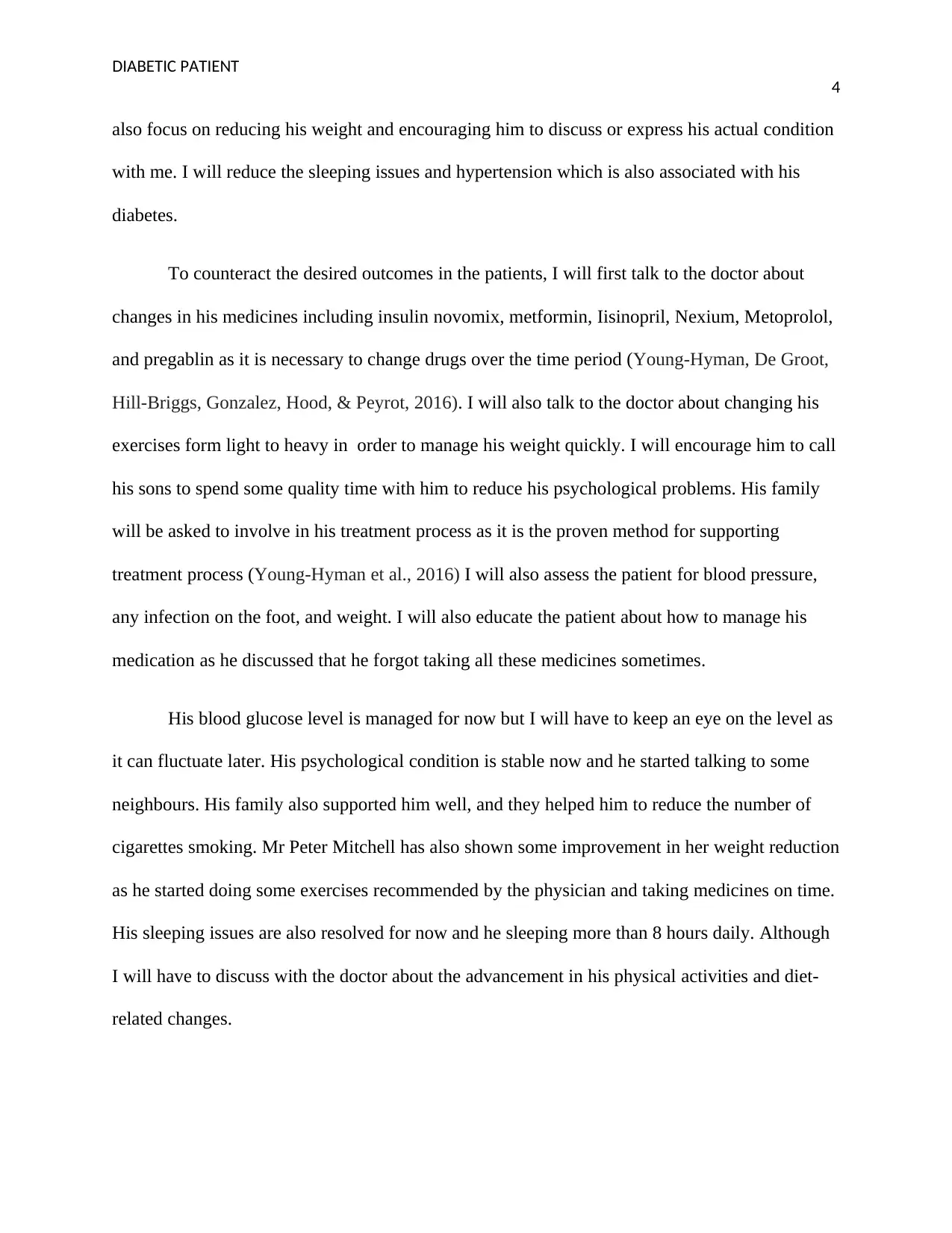
DIABETIC PATIENT
4
also focus on reducing his weight and encouraging him to discuss or express his actual condition
with me. I will reduce the sleeping issues and hypertension which is also associated with his
diabetes.
To counteract the desired outcomes in the patients, I will first talk to the doctor about
changes in his medicines including insulin novomix, metformin, Iisinopril, Nexium, Metoprolol,
and pregablin as it is necessary to change drugs over the time period (Young-Hyman, De Groot,
Hill-Briggs, Gonzalez, Hood, & Peyrot, 2016). I will also talk to the doctor about changing his
exercises form light to heavy in order to manage his weight quickly. I will encourage him to call
his sons to spend some quality time with him to reduce his psychological problems. His family
will be asked to involve in his treatment process as it is the proven method for supporting
treatment process (Young-Hyman et al., 2016) I will also assess the patient for blood pressure,
any infection on the foot, and weight. I will also educate the patient about how to manage his
medication as he discussed that he forgot taking all these medicines sometimes.
His blood glucose level is managed for now but I will have to keep an eye on the level as
it can fluctuate later. His psychological condition is stable now and he started talking to some
neighbours. His family also supported him well, and they helped him to reduce the number of
cigarettes smoking. Mr Peter Mitchell has also shown some improvement in her weight reduction
as he started doing some exercises recommended by the physician and taking medicines on time.
His sleeping issues are also resolved for now and he sleeping more than 8 hours daily. Although
I will have to discuss with the doctor about the advancement in his physical activities and diet-
related changes.
4
also focus on reducing his weight and encouraging him to discuss or express his actual condition
with me. I will reduce the sleeping issues and hypertension which is also associated with his
diabetes.
To counteract the desired outcomes in the patients, I will first talk to the doctor about
changes in his medicines including insulin novomix, metformin, Iisinopril, Nexium, Metoprolol,
and pregablin as it is necessary to change drugs over the time period (Young-Hyman, De Groot,
Hill-Briggs, Gonzalez, Hood, & Peyrot, 2016). I will also talk to the doctor about changing his
exercises form light to heavy in order to manage his weight quickly. I will encourage him to call
his sons to spend some quality time with him to reduce his psychological problems. His family
will be asked to involve in his treatment process as it is the proven method for supporting
treatment process (Young-Hyman et al., 2016) I will also assess the patient for blood pressure,
any infection on the foot, and weight. I will also educate the patient about how to manage his
medication as he discussed that he forgot taking all these medicines sometimes.
His blood glucose level is managed for now but I will have to keep an eye on the level as
it can fluctuate later. His psychological condition is stable now and he started talking to some
neighbours. His family also supported him well, and they helped him to reduce the number of
cigarettes smoking. Mr Peter Mitchell has also shown some improvement in her weight reduction
as he started doing some exercises recommended by the physician and taking medicines on time.
His sleeping issues are also resolved for now and he sleeping more than 8 hours daily. Although
I will have to discuss with the doctor about the advancement in his physical activities and diet-
related changes.
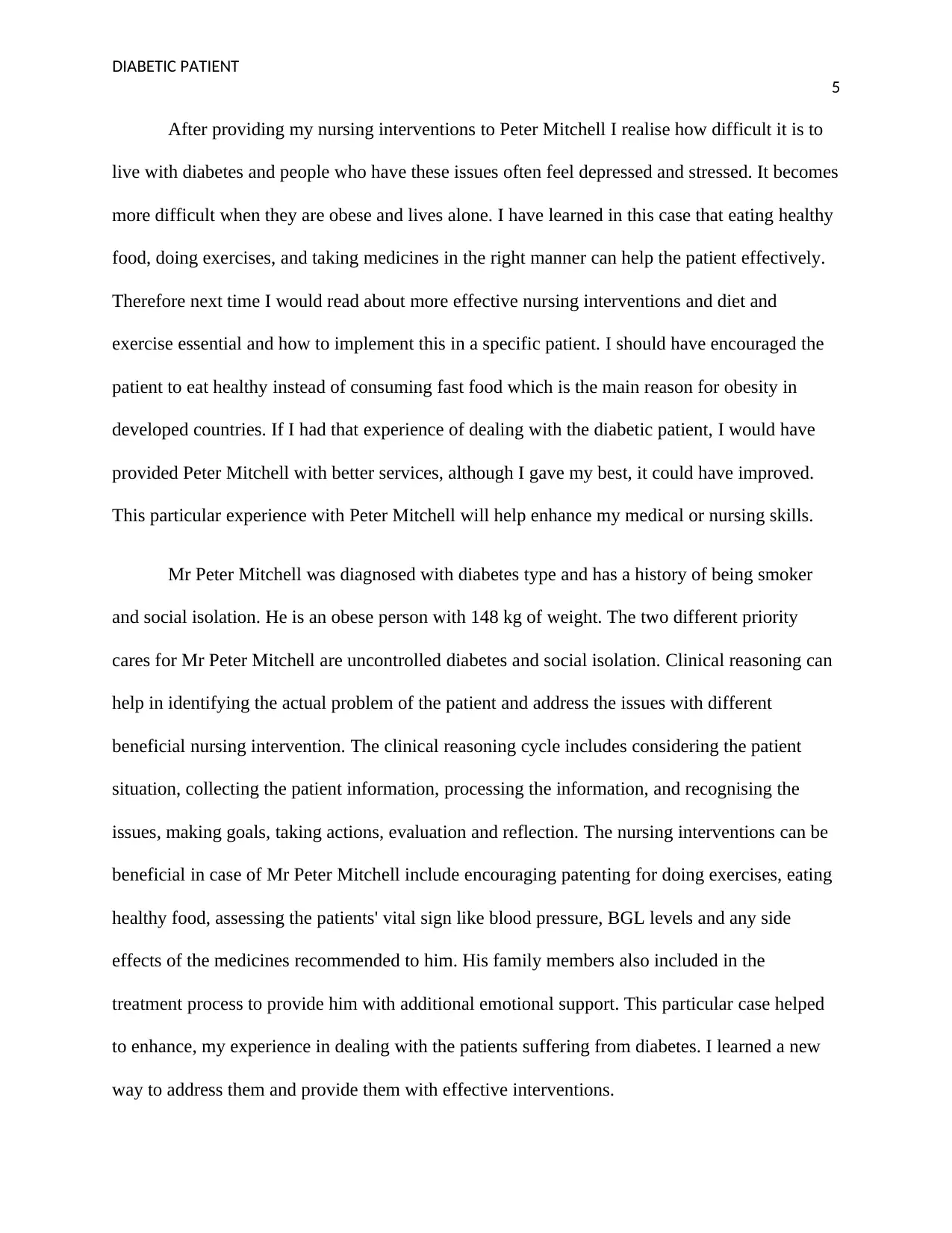
DIABETIC PATIENT
5
After providing my nursing interventions to Peter Mitchell I realise how difficult it is to
live with diabetes and people who have these issues often feel depressed and stressed. It becomes
more difficult when they are obese and lives alone. I have learned in this case that eating healthy
food, doing exercises, and taking medicines in the right manner can help the patient effectively.
Therefore next time I would read about more effective nursing interventions and diet and
exercise essential and how to implement this in a specific patient. I should have encouraged the
patient to eat healthy instead of consuming fast food which is the main reason for obesity in
developed countries. If I had that experience of dealing with the diabetic patient, I would have
provided Peter Mitchell with better services, although I gave my best, it could have improved.
This particular experience with Peter Mitchell will help enhance my medical or nursing skills.
Mr Peter Mitchell was diagnosed with diabetes type and has a history of being smoker
and social isolation. He is an obese person with 148 kg of weight. The two different priority
cares for Mr Peter Mitchell are uncontrolled diabetes and social isolation. Clinical reasoning can
help in identifying the actual problem of the patient and address the issues with different
beneficial nursing intervention. The clinical reasoning cycle includes considering the patient
situation, collecting the patient information, processing the information, and recognising the
issues, making goals, taking actions, evaluation and reflection. The nursing interventions can be
beneficial in case of Mr Peter Mitchell include encouraging patenting for doing exercises, eating
healthy food, assessing the patients' vital sign like blood pressure, BGL levels and any side
effects of the medicines recommended to him. His family members also included in the
treatment process to provide him with additional emotional support. This particular case helped
to enhance, my experience in dealing with the patients suffering from diabetes. I learned a new
way to address them and provide them with effective interventions.
5
After providing my nursing interventions to Peter Mitchell I realise how difficult it is to
live with diabetes and people who have these issues often feel depressed and stressed. It becomes
more difficult when they are obese and lives alone. I have learned in this case that eating healthy
food, doing exercises, and taking medicines in the right manner can help the patient effectively.
Therefore next time I would read about more effective nursing interventions and diet and
exercise essential and how to implement this in a specific patient. I should have encouraged the
patient to eat healthy instead of consuming fast food which is the main reason for obesity in
developed countries. If I had that experience of dealing with the diabetic patient, I would have
provided Peter Mitchell with better services, although I gave my best, it could have improved.
This particular experience with Peter Mitchell will help enhance my medical or nursing skills.
Mr Peter Mitchell was diagnosed with diabetes type and has a history of being smoker
and social isolation. He is an obese person with 148 kg of weight. The two different priority
cares for Mr Peter Mitchell are uncontrolled diabetes and social isolation. Clinical reasoning can
help in identifying the actual problem of the patient and address the issues with different
beneficial nursing intervention. The clinical reasoning cycle includes considering the patient
situation, collecting the patient information, processing the information, and recognising the
issues, making goals, taking actions, evaluation and reflection. The nursing interventions can be
beneficial in case of Mr Peter Mitchell include encouraging patenting for doing exercises, eating
healthy food, assessing the patients' vital sign like blood pressure, BGL levels and any side
effects of the medicines recommended to him. His family members also included in the
treatment process to provide him with additional emotional support. This particular case helped
to enhance, my experience in dealing with the patients suffering from diabetes. I learned a new
way to address them and provide them with effective interventions.
⊘ This is a preview!⊘
Do you want full access?
Subscribe today to unlock all pages.

Trusted by 1+ million students worldwide
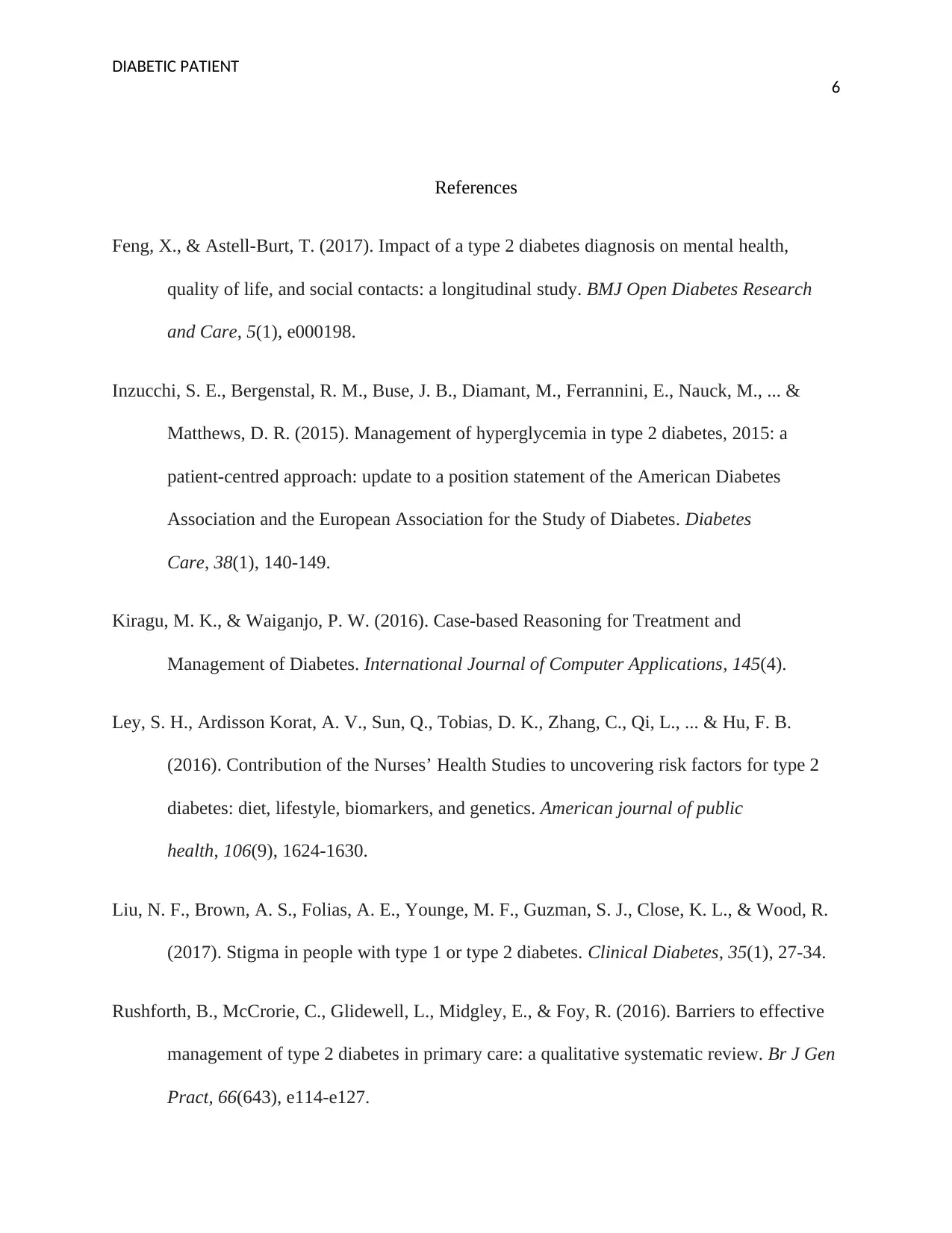
DIABETIC PATIENT
6
References
Feng, X., & Astell-Burt, T. (2017). Impact of a type 2 diabetes diagnosis on mental health,
quality of life, and social contacts: a longitudinal study. BMJ Open Diabetes Research
and Care, 5(1), e000198.
Inzucchi, S. E., Bergenstal, R. M., Buse, J. B., Diamant, M., Ferrannini, E., Nauck, M., ... &
Matthews, D. R. (2015). Management of hyperglycemia in type 2 diabetes, 2015: a
patient-centred approach: update to a position statement of the American Diabetes
Association and the European Association for the Study of Diabetes. Diabetes
Care, 38(1), 140-149.
Kiragu, M. K., & Waiganjo, P. W. (2016). Case-based Reasoning for Treatment and
Management of Diabetes. International Journal of Computer Applications, 145(4).
Ley, S. H., Ardisson Korat, A. V., Sun, Q., Tobias, D. K., Zhang, C., Qi, L., ... & Hu, F. B.
(2016). Contribution of the Nurses’ Health Studies to uncovering risk factors for type 2
diabetes: diet, lifestyle, biomarkers, and genetics. American journal of public
health, 106(9), 1624-1630.
Liu, N. F., Brown, A. S., Folias, A. E., Younge, M. F., Guzman, S. J., Close, K. L., & Wood, R.
(2017). Stigma in people with type 1 or type 2 diabetes. Clinical Diabetes, 35(1), 27-34.
Rushforth, B., McCrorie, C., Glidewell, L., Midgley, E., & Foy, R. (2016). Barriers to effective
management of type 2 diabetes in primary care: a qualitative systematic review. Br J Gen
Pract, 66(643), e114-e127.
6
References
Feng, X., & Astell-Burt, T. (2017). Impact of a type 2 diabetes diagnosis on mental health,
quality of life, and social contacts: a longitudinal study. BMJ Open Diabetes Research
and Care, 5(1), e000198.
Inzucchi, S. E., Bergenstal, R. M., Buse, J. B., Diamant, M., Ferrannini, E., Nauck, M., ... &
Matthews, D. R. (2015). Management of hyperglycemia in type 2 diabetes, 2015: a
patient-centred approach: update to a position statement of the American Diabetes
Association and the European Association for the Study of Diabetes. Diabetes
Care, 38(1), 140-149.
Kiragu, M. K., & Waiganjo, P. W. (2016). Case-based Reasoning for Treatment and
Management of Diabetes. International Journal of Computer Applications, 145(4).
Ley, S. H., Ardisson Korat, A. V., Sun, Q., Tobias, D. K., Zhang, C., Qi, L., ... & Hu, F. B.
(2016). Contribution of the Nurses’ Health Studies to uncovering risk factors for type 2
diabetes: diet, lifestyle, biomarkers, and genetics. American journal of public
health, 106(9), 1624-1630.
Liu, N. F., Brown, A. S., Folias, A. E., Younge, M. F., Guzman, S. J., Close, K. L., & Wood, R.
(2017). Stigma in people with type 1 or type 2 diabetes. Clinical Diabetes, 35(1), 27-34.
Rushforth, B., McCrorie, C., Glidewell, L., Midgley, E., & Foy, R. (2016). Barriers to effective
management of type 2 diabetes in primary care: a qualitative systematic review. Br J Gen
Pract, 66(643), e114-e127.
Paraphrase This Document
Need a fresh take? Get an instant paraphrase of this document with our AI Paraphraser
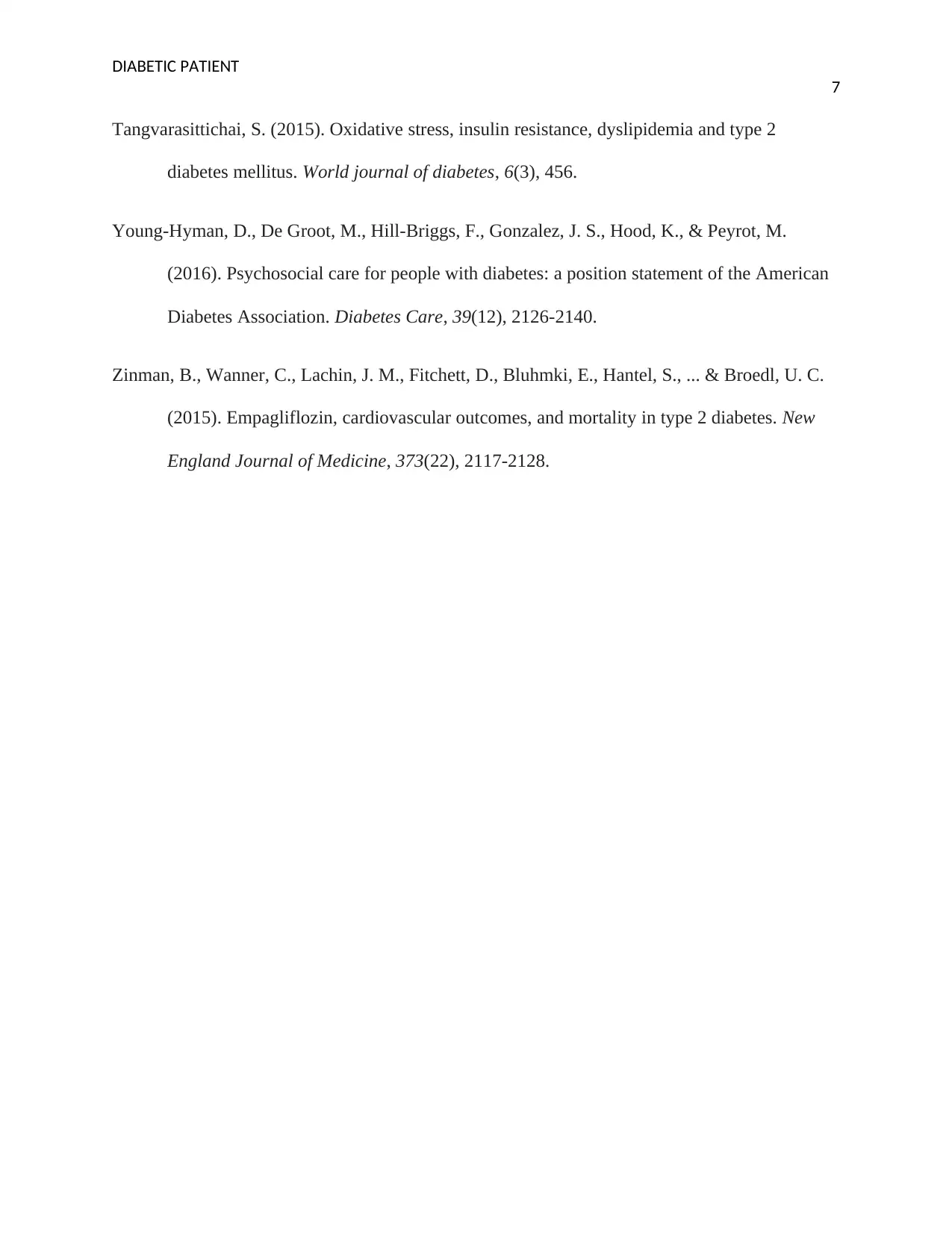
DIABETIC PATIENT
7
Tangvarasittichai, S. (2015). Oxidative stress, insulin resistance, dyslipidemia and type 2
diabetes mellitus. World journal of diabetes, 6(3), 456.
Young-Hyman, D., De Groot, M., Hill-Briggs, F., Gonzalez, J. S., Hood, K., & Peyrot, M.
(2016). Psychosocial care for people with diabetes: a position statement of the American
Diabetes Association. Diabetes Care, 39(12), 2126-2140.
Zinman, B., Wanner, C., Lachin, J. M., Fitchett, D., Bluhmki, E., Hantel, S., ... & Broedl, U. C.
(2015). Empagliflozin, cardiovascular outcomes, and mortality in type 2 diabetes. New
England Journal of Medicine, 373(22), 2117-2128.
7
Tangvarasittichai, S. (2015). Oxidative stress, insulin resistance, dyslipidemia and type 2
diabetes mellitus. World journal of diabetes, 6(3), 456.
Young-Hyman, D., De Groot, M., Hill-Briggs, F., Gonzalez, J. S., Hood, K., & Peyrot, M.
(2016). Psychosocial care for people with diabetes: a position statement of the American
Diabetes Association. Diabetes Care, 39(12), 2126-2140.
Zinman, B., Wanner, C., Lachin, J. M., Fitchett, D., Bluhmki, E., Hantel, S., ... & Broedl, U. C.
(2015). Empagliflozin, cardiovascular outcomes, and mortality in type 2 diabetes. New
England Journal of Medicine, 373(22), 2117-2128.
1 out of 8
Related Documents
Your All-in-One AI-Powered Toolkit for Academic Success.
+13062052269
info@desklib.com
Available 24*7 on WhatsApp / Email
![[object Object]](/_next/static/media/star-bottom.7253800d.svg)
Unlock your academic potential
Copyright © 2020–2025 A2Z Services. All Rights Reserved. Developed and managed by ZUCOL.





